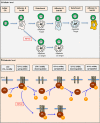Oxidative downmodulation of T cell-mediated cytotoxicity
- PMID: 27899817
- PMCID: PMC5059872
- DOI: 10.1038/cddis.2016.273
Oxidative downmodulation of T cell-mediated cytotoxicity
Figures

References
MeSH terms
Substances
LinkOut - more resources
Full Text Sources
Other Literature Sources

